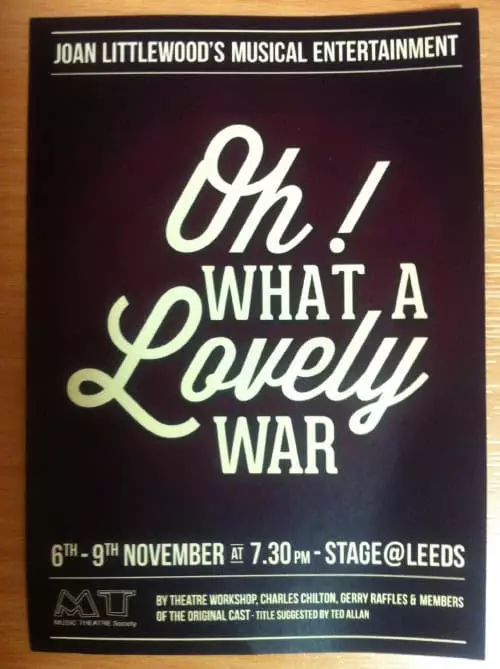Oh! What a Lovely War, 6th Nov stage@leeds, reviewed by By Zosh Skowronska …
Despite being a classic piece of musical theatre, Oh! What a Lovely War never ceases to amaze me with its ironic and light hearted approach to the seriousness and brutality of war.
But MT (Music Theatre) society at University of Leeds put on a fantastic production of the show with only 14 student actors, compared to the cast of over 50 that Joan Littlewood wrote parts for. Add to this an impressive set, brilliant authentic costumes and eye-catching set design and this production delivered.
Using scrap corrugated metal, designer (Phili Reynolds) transformed upstage into a base camp with a raised central walkway through the metal to downstage. This also functioned as a shield to fence in the band, who were present onstage for the entire performance, giving the whole piece continuity and highlighting them as an integral part of the production.
As we walked to our seats, a large man dressed in army gear was clearly visible in a spotlight, with an atmospheric thick haze over the stage. This combined with a deafening noise made for a rightfully unsettling and uncomfortable opening to the production.
A single strand of stark yellow light bulbs dimly lit the upstage set. We never know exactly where this is set, but we don’t particularly need to, we just need to get an idea of the brutal experience of living through war.
A screen lit by a projector hanging high above the stage, was used effectively during the opening scene, where clips and images from worldwide news reports on present day war and conflict were shown. This was a great way to open the piece as it immediately updated this classic piece of performance and gave us an alternative view to the original intentions and setting of the musical. The projector also displayed facts and time frames related to the action onstage – however, this was sometimes incorrect, making it distracting, as opposed to informative.
Due to the chaotic lighting (blue, red, purple) mixed with a sometimes thick haze over the stage, it was a struggle to read these projections, taking focus away from the action onstage. I was determined to make sense of what was on the screen, whereas a large part of the audience, I suspect wouldn’t bother.
MT’s props were used brilliantly as comic devices. During the second act, we see the British soldiers in the trenches, getting a visit from an officer. In this case ‘he’ was one of the girls (Serena Brett) wearing a hat and a long black leather coat. This in itself was comic, the opposite of a stereotypical authoritative officer.
The moment where she spies a gory, severed leg placed downstage, to ‘hold up the side of the trench’ unlikely as it sounds was also pure comedy. Another eye catching moment for me was when two female actors came on holding a washing line with clothing coloured one side with the Union Jack and the other with the German flag. Turning the washing around illustrated a change of country/setting, therefore changing accents rapidly to represent the gossip on war in two different countries. This was an ingenious idea, which perfectly captured the gossipy nature of housewives during the war.
Through the vast array of German, Russian, French and British accents, it was clear who was fighting for whom. But despite the realistic delivery of these accents, it was sometimes hard to understand what the actors were trying to say, their diction got lost within the limitations of accents.
There were occasions where I felt the actors weren’t wholeheartedly throwing themselves into the roles they were playing. When I see a musical I expect to see ear-to-ear dazzling smiles, precise polished choreography and above all an overwhelming amount of energy. This was not always the case – I really don’t think a half-hearted smile and a few leg kicks will do!
(too harsh?)
Fortunately the music and singing, which is at the heart of the show, was definitely a strength of the performance, all the performers had fantastic singing voices and mostly performed with clarity, humour and passion. There were a number of times throughout the performance where songs were used as transitions between scenes, actors would enter already singing and end up on stage. These seamless transitions gave the whole performance a sense of professionalism and pace.
